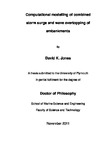Computational modelling of combined storm surge and wave overtopping of embankments
| dc.contributor.supervisor | Reeve, Dominic | |
| dc.contributor.author | Jones, David K | |
| dc.contributor.other | Faculty of Science and Engineering | en_US |
| dc.date.accessioned | 2012-03-26T10:12:55Z | |
| dc.date.available | 2012-03-26T10:12:55Z | |
| dc.date.issued | 2012 | |
| dc.identifier | 358170 | en_US |
| dc.identifier.uri | http://hdl.handle.net/10026.1/920 | |
| dc.description.abstract |
The primary function of seawalls and embankments is to protect against damage and injury caused by flooding. Coastal flooding is caused by combinations of high tides, waves, wind set-up and storm surges driven by low-pressure systems. However with global warming causing sea levels to rise and with increased storminess causing more extreme waves and storm surges, the likelihood of overtopping of seawalls with zero or negative freeboard may well be expected to increase. Researchers using physical and numerical models to develop design formulae have widely investigated wave overtopping of seawalls with positive freeboard. However the design of seawalls with zero or negative freeboard has attracted much less attention, and some variation exists between overtopping discharge calculated with current design formulae. The focus of this thesis is the extreme situation when overtopping caused by storm waves is combined with surge levels above the embankment crest. The local highly accelerative flow over the embankment crest caused by the high surge level will significantly alter the flow at the crest. This is likely to have a highly non-linear effect upon the overtopping waves. In this thesis, the flow is investigated with a 2DV numerical model based on the Reynolds averaged Navier-Stokes (RANS) equations developed by Lin and Liu (1998a). The model describes the flow characteristics of a breaking wave such as the velocities within the wave as well as the turbulence at the seabed boundary layer. As an example of the model’s ability to describe complex hydrodynamic flows, this study investigates its ability to represent the second order mass transport under progressive and standing waves. The model results are compared with available theory and experimental results. This shows that mass transport is successfully predicted, although there is some variation in the magnitude compared to the experimental and theoretical results. To consider the model’s ability to simulate storm surge wave overtopping of embankments, the RANS model has been used to simulate an experimental study conducted by Hughes and Nadal (2009). To examine the success of the model at reproducing the wave generation, transformation and overtopping processes the model results have been compared with the experimental laboratory data. This makes possible a wave-by-wave comparison of overtopping parameters such as discharge, depth and velocity for a storm surge event. Additionally the overtopping discharge predicted by the model is compared with design formulae and the differences in the overtopping discharge calculated with current design formulae are investigated and explained. Finally, the RANS model is used to determine the effect of embankment crest width on the magnitude of the overtopping discharge. Results from RANS model tests are used to provide design guidance in the form of an equation that allows the effect of crest width to be included when evaluating combined discharge at embankments. | en_US |
| dc.description.sponsorship | Britannia Royal Naval College | en_US |
| dc.language.iso | en | en_US |
| dc.publisher | University of Plymouth | en_US |
| dc.subject | extreme | en_US |
| dc.subject | wave overtopping | en_US |
| dc.subject | embankment | en_US |
| dc.subject | wave model | en_US |
| dc.subject | mass transport | en_US |
| dc.title | Computational modelling of combined storm surge and wave overtopping of embankments | en_US |
| dc.type | Thesis | |
| dc.identifier.doi | http://dx.doi.org/10.24382/3727 |
Files in this item
This item appears in the following Collection(s)
-
01 Research Theses Main Collection
Research Theses Main


